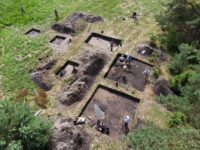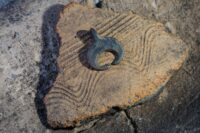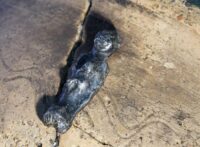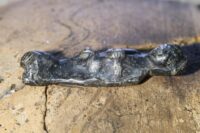 Archaeologists excavating the site of an early medieval hillfort in Chodlik, eastern Poland, have unearthed an unusual silver anthropomorphic figurine among other artifacts that shed new light on the settlement’s history.
Archaeologists excavating the site of an early medieval hillfort in Chodlik, eastern Poland, have unearthed an unusual silver anthropomorphic figurine among other artifacts that shed new light on the settlement’s history.
Chodlik, 30 miles west of the city of Lublin, is one of the most archaeologically rich areas in the Lublin Voivodeship. It was site of a heavily fortified stronghold built and occupied by the Slavs between the 8th and the 10th century. It was the largest stronghold of the period in Poland, and its location at the junction of the major east-west and north-south roads made it an epicenter of settlement in the region.
 The site has been excavated off and on for 60 years, revealing burials mounds, remains of fortifications and the largest early medieval granary ever found in Europe. The last two seasons focused on an area that geophysical surveys indicated might contain man-made structures. Archaeologists have unearthed hundreds of fragments from clay vessels and weapons including arrowheads and spears. Decorative objects, including a lunula (a pendant shaped like the crescent moon), were among the artifacts uncovered.
The site has been excavated off and on for 60 years, revealing burials mounds, remains of fortifications and the largest early medieval granary ever found in Europe. The last two seasons focused on an area that geophysical surveys indicated might contain man-made structures. Archaeologists have unearthed hundreds of fragments from clay vessels and weapons including arrowheads and spears. Decorative objects, including a lunula (a pendant shaped like the crescent moon), were among the artifacts uncovered.
A two-inch-high silver figurine was the stand-out find, discovered less than eight inches beneath the surface at the early medieval archaeological layer. The figure has clasped hands crossing its chest and clearly-defined feet. Facial features have been lost from wear and tear. It’s possible the figurine once held an object, now worn away, in its hands. Researchers are looking for comparable objects in an attempt to identify the figurine, but thus far have come up empty handed.
The discovered fragments of ceramic vessels come from the 8th-10th centuries, which confirmed the earlier findings of archaeologists regarding the centuries of the defensive foundation. Their great number means, according to [Polish Academy of Sciences archaeologist Dr. Łukasz] Miechowicz that the place was teeming with life. In turn, the military was discovered at the base of the outer rampart.
“These monuments may be traces of military actions. The Chodel Basin is a very strongly fortified settlement microregion – there are 4 very close castles, additional fortifications in the form of a longitudinal embankment, and two important trade routes intersected here. It was certainly a rich place and a tasty morsel” — said the scientist.
This year, archaeologists also found two early medieval denarii at the base of the embankment in Chodlik. According to experts, they come from the beginning of the 11th century. Until now, researchers believed that the stronghold ceased to exist in the 10th century. and Podgórze. “The new finds of coins give impetus to research on the chronology of the hillfort in Chodlik and its possible shift to the 11th century, here we also count on the results of absolute dating using the radiocarbon method,” Miechowicz added. Until now, it was believed that the stronghold in Chodlik ceased to exist when the Piast state was established. The reason for its end, however, remains a mystery to this day. Perhaps a natural disaster, perhaps an armed invasion, contributed to this.

